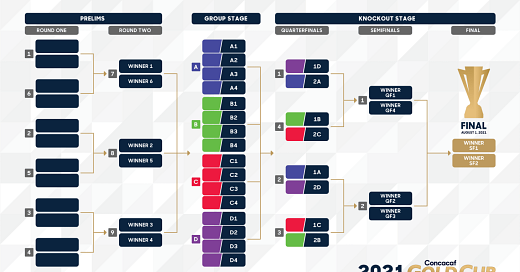🏆 Concacaf puts sport ahead of business with first-ever Gold Cup draw
Inviting Qatar to the continental championship is a little more suspect.

Groups are assigned, not drawn.
It’s been a reminder passed around jokingly in the Concacaf nerd community (of which you perhaps - no, likely - are a part of if you are reading this newsletter). The continental championship was intentionally structured to maximize profit, not necessarily to see which team is the best in a sporting sense.
That changed Wednesday, with Concacaf announcing it will conduct an inaugural Gold Cup draw on Sept. 28. Mexico and the United States won’t be on a collision course to meet in the final - or if they will it will be determined by the randomness of ping-pong balls.
“I … believe that having a draw for this competition is a long time coming and fits with our objective to be a truly football first organization,” Concacaf President Victor Montagliani said in a news release. “It will provide great anticipation for fans as they look forward to the return of international football in our region.”
Some commercial considerations will, no doubt, still be put in place. It’s difficult to imagine Concacaf no longer putting its thumb on the scale in terms of venues. Look for whatever group Mexico ends up in to have a Southwest-heavy schedule, while the Americans’ group will surely see trips to strongholds of USMNT fandom in the Midwest or Northeast.
Yet, the potential of the region’s most lucrative matchup taking place in a quarterfinal venue rather than only in the final sets a good precedent. And, truth be told, is it that much different to have a guaranteed packed house in the quarterfinals rather than the last game of the tournament?
There have been small steps toward a more competitive and legitimate competition in the last two editions. For one, the expansion of the tournament by four teams has done little to dilute the quality, with upset runs by teams like Haiti and Curacao among the highlights of the last two tournaments.
Matches taking place outside the United States also pave the way for the potential of the entire tournament moving from the U.S. As I’ve long argued, there’s no reason a country that can successfully host the Women’s World Cup like Canada or is hosting FIFA World Cup matches in 2026 like Mexico shouldn’t be able to host an entire Gold Cup. And only conducting the tournament in North America isn’t sporting either. CONMEBOL manages to rotate the Copa America between its member associations, even though there are clear advantages to conducting the tournament in, say, Brazil rather than Bolivia.
Of course, the profits would be smaller. You won’t fill a stadium for an El Salvador match in Guadalajara or Kingston like you would in Washington D.C. But it’s a sacrifice worth being made for the sporting side of the competition.
Concacaf may never be able to stop the tug of war between business and sport. We’re likely to see the battle continue for the rest of our lives. In this case, however, Concacaf has put sport ahead of business, creating a more legitimate competition and one fans will have an easier time supporting even if the profits aren’t as large.
The decision to invite Qatar to the Gold Cup in both 2021 and 2023, the first invited team to the competition since Colombia and South Africa took part in 2005, is a reminder that politics will make up the third member of the Holy Trinity of international sport.
Concacaf’s partnership with the Asian Football Confederation makes sense even from a sporting perspective. As two ‘outsider’ confederations, figuring out when to follow the example set by Europe and when to plot a new course are challenges on which leaders from both groups can consult each other.
Yet, it’s hard to see the benefit on the sporting side of the the coming together of Concacaf and the Qatar Football Association and the Supreme Committee for Delivery & Legacy. In fact, the initial announcement makes it seem as though the addition of a guest team has necessitated a preliminary round that will slow the growth of some of Concacaf’s smaller members rather than igniting it.
A dozen teams that were hoping to test their mettle against the confederation’s top squads will instead play against … each other … in an effort to secure one of just three slots in the group stage of the tournament.
Want to read about those teams in addition to the big boys? Make sure you’re subscribed:
Most teams that long have dreamed to get into the Gold Cup won’t make it through this preliminary round. Maybe it fortifies the ones that make it as they head into the group stages of the competition and they’ll better be able to compete with teams like Mexico, Costa Rica and the United States. Yet, it also cheapens the achievement of making the tournament if a team doesn’t make the group stage, and, perhaps critically for many Caribbean nations, it extend the time commitment required from Europe-based players taking time away from their summer holidays or preseason training camps depending on scheduling.
Today there is a bit of hope that Concacaf will resolve some of these issues with what’s best for the growth of the game in the region, like it has done by implementing with a draw. There are still plenty of things that need to be done to improve the Gold Cup, but the powers that be in the confederation took a good step Wednesday.
What do you think? Convinced by the addition of a draw? Is it one step forward, two back with the Qatar edition? Leave a comment by clicking this big button that says “Leave a comment”




